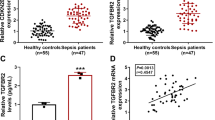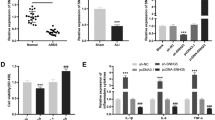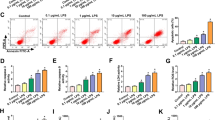Abstract
Background
Long non-coding RNA (lncRNA) cancer susceptibility candidate 9 (CASC9) is reported to be linked to cancers. This research aims to explore the role and possible mechanism of CASC9 in lung injury induced by sepsis.
Methods
Lipopolysaccharide (LPS) induced human small airway epithelial cells (HSAECs) were established in vitro to mimic sepsis-induced lung injury. The effects of CASC9 and miR-195-5p on HSAECs viability were studied by CCK-8 assay. Interactions between CASC9 and miR-195-5p were determined by bioinformatics analysis, RT-PCR, dual luciferase reporter assay, and RNA immunoprecipitation assay. Pyruvate dehydrogenase kinase 4 (PDK4) and apoptosis-related molecules including Bcl2 and Bad were detected by western blot. Additionally, sepsis-induced lung injury model in rats was established by intraperitoneal injection of LPS in vivo to validate the demonstrations of in vitro studies.
Results
CASC9 was markedly down-regulated while miR-195-5p was significantly up-regulated in HSAECs treated by LPS and lung tissues of rats with sepsis. CASC9 interacted with miR-195-5p, and negatively regulated its expression level. Overexpression of CASC9 or transfection of miR-195-5p inhibitors significantly promoted the viability of HSAECs. The transfection of miR-195-5p mimics effected oppositely. For mechanism, miR-195-5p targeted the 3′UTR of pyruvate dehydrogenase kinase 4 (PDK4) gene and depressed the protein level, and PDK4 was regulated indirectly by CASC9. Restoration of CASC9 in the lung tissues of rats with sepsis ameliorated lung injury.
Conclusion
CASC9 protects lung epithelial cells from sepsis-induced injury via regulating miR-195-5p/PDK4 axis.





Similar content being viewed by others
Data availability statement
The data used to support the findings of this study are available from the corresponding author upon request.
References
Fattahi F, Ward PA. Understanding immunosuppression after sepsis. Immunity. 2017;47(1):3–5.
Hassan U, Ghonge T, Reddy B Jr, Patel M, Rappleye M, Taneja I, et al. A point-of-care microfluidic biochip for quantification of CD64 expression from whole blood for sepsis stratification. Nat Commun. 2017;3(8):15949.
Song C, Li H, Li Y, Dai M, Zhang L, Liu S, et al. NETs promote ALI/ARDS inflammation by regulating alveolar macrophage polarization. Exp Cell Res. 2019;382(2):111486.
Wang KC, Yang YW, Liu B, Anyal A, Corces-Zimmerman R, Chen Y, et al. A long noncoding RNA maintains active chromatin to coordinate homeotic gene expression. Nature. 2011;472(7341):120–4.
Zhou Z, Zhu Y, Gao G, Zhang Y. Long noncoding RNA SNHG16 targets miR-146a-5p/CCL5 to regulate LPS-induced WI-38 cell apoptosis and inflammation in acute pneumonia. Life Sci. 2019;1(228):189–97.
Yuan J, Li M, Chang X, Chen Y, Dong C. Clinical value of non-coding RNA molecular markers for sepsis. Zhonghua Wei Zhong Bing Ji Jiu Yi Xue. 2019;31(5):650–3.
Brandenburger T, Salgado Somoza A, Devaux Y, Lorenzen JM. Noncoding RNAs in acute kidney injury. Kidney Int. 2018;94(5):870–81.
Luo K, Geng J, Zhang Q, Xu Y, Zhou X, Huang Z, et al. LncRNA CASC9 interacts with CPSF3 to regulate TGF-β signaling in colorectal cancer. J Exp Clin Cancer Res. 2019;38(1):249.
Shao G, Wang M, Fan X, Zhong L, Wang Z, Zhang P, Ji S. lncRNA CASC9 positively regulates CHK1 to promote breast cancer cell proliferation and survival through sponging the miR‑195/497 cluster. Int J Oncol. 2019;54(5):1665–75.
Guarnieri DJ, Dileone RJ. MicmRNAs:a new class of gene regulators. Ann Med. 2008;40(3):197–208.
Szilágyi B, Fejes Z, Pócsi M, Kappelmayer J, Nagy B Jr. Role of sepsis modulated circulating microRNAs. EJIFCC. 2019;30(2):128–45.
Zhang W, Jia J, Liu Z, Si D, Ma L, Zhang G. Circulating microRNAs as biomarkers for sepsis secondary to pneumonia diagnosed via sepsis 3.0. BMC Pulm Med. 2019;19(1):93.
Bai J, Xu J, Zhao J, Zhang R. lncRNA SNHG1 cooperated with miR-497/miR-195-5p to modify epithelial-mesenchymal transition underlying colorectal cancer exacerbation. J Cell Physiol. 2019. https://doi.org/10.1002/jcp.29065.
Du P, Liu F, Liu Y, Shao M, Li X, Qin G. Linc00210 enhances the malignancy of thyroid cancer cells by modulating miR-195-5p/IGF1R/Akt axis. J Cell Physiol. 2019. https://doi.org/10.1002/jcp.29016.
Herbst EA, Dunford EC, Harris RA, Vandenboom R, Leblanc PJ, Roy BD. Role of pyruvate dehydrogenase kinase 4 in regulating PDH activation during acute muscle contraction. Appl Physiol Nutr Metab. 2012;37(1):48–52.
Wu J, Zhao Y, Park YK, Lee JY, Gao L, Zhao J, Wang L. Loss of PDK4 switches the hepatic NF-κB/TNF pathway from pro-survival to pro-apoptosis. Hepatology. 2018. https://doi.org/10.1002/hep.29902.
Varadhan KK, Constantin-Teodosiu D, Constantin D, Greenhaff PL, Lobo DN. Inflammation-mediated muscle metabolic dysregulation local and remote to the site of major abdominal surgery. Clin Nutr. 2018;37(6 Pt A):2178–85.
Constantin D, McCullough J, Mahajan RP, Greenhaff PL. Novel events in the molecular regulation of muscle mass in critically ill patients. J Physiol. 2011;589(Pt 15):3883–955.
Hung Y-L, Fang S-H, Wang S-C, Cheng W-C, Liu P-L, Chia-Cheng Su, Chen C-S, Huang M-Y, Hua K-F, Shen K-H, Wang Y-T, Suzuki K, Lib C-Y. Corylin protects LPS-induced sepsis and attenuates LPS-induced inflammatory response. Sci Rep. 2017;7:46299.
Wu H, Liu J, Li W, Liu G, Li Z. LncRNA-HOTAIR promotes TNF-α production in cardiomyocytes of LPS-induced sepsis mice by activating NF-κB pathway. Biochem Biophys Res Commun. 2016;471(1):240–6.
Zhang T, Xiang L. Honokiol alleviates sepsis-induced acute kidney injury in mice by targeting the miR-218-5p/heme oxygenase-1 signaling pathway. Cell Mol Biol Lett. 2019;24:15.
Wang SM, Liu GQ, Xian HB, Si JL, Qi SX, Yu YP. LncRNA NEAT1 alleviates sepsis-induced myocardial injury by regulating the TLR2/NF-κB signaling pathway. Eur Rev Med Pharmacol Sci. 2019;23(11):4898–907.
Jiang ZJ, Zhang MY, Fan ZW, Sun WL, Tang Y. Influence of lncRNA HOTAIR on acute kidney injury in sepsis rats through regulating miR-34a/Bcl-2 pathway. Eur Rev Med Pharmacol Sci. 2019;23(8):3512–9.
Zhu L, Wei T, Gao J, Chang X, He H, Luo F, et al. The cardioprotective effect of salidroside against myocardial ischemia reperfusion injury in rats by inhibiting apoptosis and inflammation. Apoptosis. 2015;20(11):1433–43.
Cao C, Zhang Y, Chai Y, Wang L, Yin C, Shou S, Jin H. Attenuation of sepsis-induced cardiomyopathy by regulation of microrna-23b is mediated through targeting of MyD88-mediated NF-κB activation. Inflammation. 2019;42(3):973–86.
Zhan CY, Chen D, Luo JL, Shi YH, Zhang YP. Protective role of down-regulated microRNA-31 on intestinal barrier dysfunction through inhibition of NF-κB/HIF-1α pathway by binding to HMOX1 in rats with sepsis. Mol Med. 2018;24(1):55.
Cao X, Zhang C, Zhang X, Chen Y, Zhang H. MiR-145 negatively regulates TGFBR2 signaling responsible for sepsis-induced acute lung injury. Biomed Pharmacother. 2019;111:852–8.
Fang Y, Hu J, Wang Z, Zong H, Zhang L, Zhang R, Sun L. LncRNA H19 functions as an aquaporin 1 competitive endogenous RNA to regulate microRNA-874 expression in LPS sepsis. Biomed Pharmacother. 2018;105:1183–91.
Li R, Fang L, Pu Q, Bu H, Zhu P, Chen Z, Yu M, et al. MEG3-4 is a miRNA decoy that regulates IL-1β abundance to initiate and then limit inflammation to prevent sepsis during lung infection. Sci Signal. 2018. https://doi.org/10.1126/scisignal.aao2387.
Zhang J, Wang Q, Quan Z. Long non-coding RNA CASC9 enhances breast cancer progression by promoting metastasis through the meditation of miR-215/TWIST2 signaling associated with TGF-β expression. Biochem Biophys Res Commun. 2019;515(4):644–50.
Du P, Liu F, Liu Y, Shao M, Li X, Qin G. Linc00210 enhances the malignancy of thyroid cancer cells by modulating miR-195-5p/IGF1R/Akt axis. J Cell Physiol. 2019. https://doi.org/10.1002/jcp.29016.
Park H, Jeoung NH. Inflammation increases pyruvate dehydrogenase kinase 4 (PDK4) expression via the Jun N-Terminal Kinase (JNK) pathway in C2C12 cells. Biochem Biophys Res Commun. 2016;469(4):1049–54.
Weng Y, Shen Y, He Y, Pan X, Xu J, Jiang Y, et al. The miR-15b-5p/PDK4 axis regulates osteosarcoma proliferation through modulation of the Warburg effect. Biochem Biophys Res Commun. 2018;503(4):2749–57.
Li G, Li M, Hu J, Lei R, Xiong H, Ji H, et al. The microRNA-182-PDK4 axis regulates lung tumorigenesis by modulating pyruvate dehydrogenase and lipogenesis. Oncogene. 2017;36(7):989–98.
Funding
None.
Author information
Authors and Affiliations
Contributions
Guarantor of integrity of the entire study: XS; Study concepts and design: XS; Experimental studies: HRW, XYG; Data analysis: HRW, XYG; Manuscript preparation: XS, YXL. All authors read and approved the final manuscript.
Corresponding author
Ethics declarations
Conflict of interest
The authors declare that they have no competing interest.
Additional information
Responsible Editor: Artur Bauhofer.
Publisher's Note
Springer Nature remains neutral with regard to jurisdictional claims in published maps and institutional affiliations.
Rights and permissions
About this article
Cite this article
Wang, Hr., Guo, Xy., Liu, Xy. et al. Down-regulation of lncRNA CASC9 aggravates sepsis-induced acute lung injury by regulating miR-195-5p/PDK4 axis. Inflamm. Res. 69, 559–568 (2020). https://doi.org/10.1007/s00011-020-01316-2
Received:
Revised:
Accepted:
Published:
Issue Date:
DOI: https://doi.org/10.1007/s00011-020-01316-2




